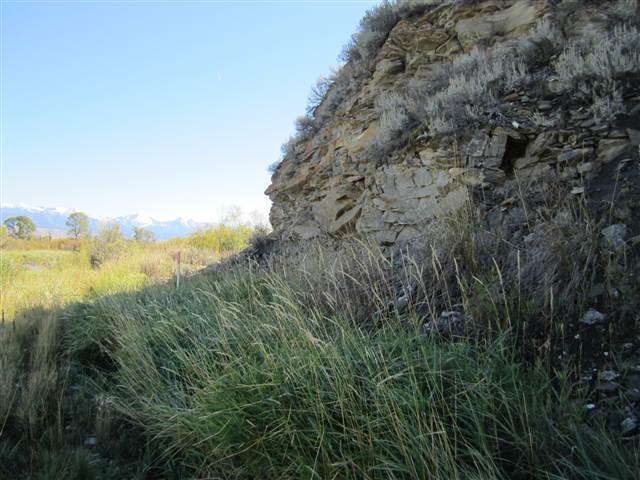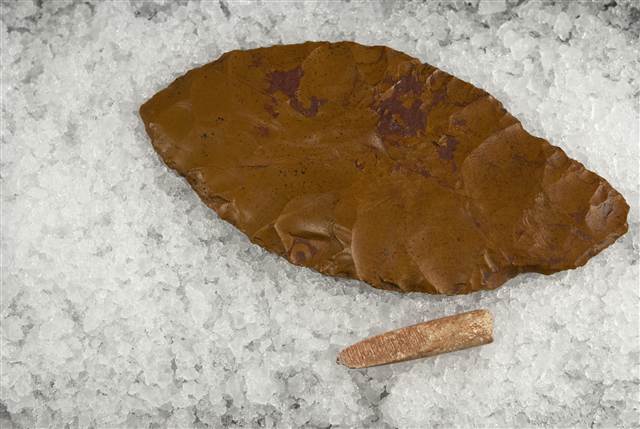BY NIDHI SUBBARAMAN, NBC news
About 12,600 years ago, when ice sheets still covered parts of North America, a baby boy lived, died and was buried in a rocky grave in a field in western Montana.
A new whole genome sequencing of this infant — the oldest genome sequence of an American individual — identifies his community as ancestors of Native Americans who live on the continent today.
“We found the genome of this boy is more closely related to Native Americans today than to any other peoples anywhere else,” Eske Willlerslev, of the University of Copenhagen, who led an international team on this study published in the Thursday issue of Nature, told reporters during a teleconference.
The new study adds to archaeological evidence that Native Americans are descendants of humans that migrated from Asia through Siberia, and thrived across North America 13,000 years ago.

At the Anzick site, a pole marks location where the burial was found.
The infant boy was discovered in 1968 by construction crews on private property belonging to the Anzick family. He was named Anzick-1, and identified as a member of the ancient Clovis people — a group that appeared between 13,000 and 12,600 years ago, and crafted strikingly distinctive spear tips made from stone.
The first of those stone tools were discovered in Clovis, New Mexico, but then unearthed all across North America. But these tools seem to be all this that this group left behind.
Because the “Clovis points” are so similar to the flint tools found at the Solutré site in France, dating back to about the same time, some researchers have proposed that the Clovis — and ancestors of Native Americans — were Europeans who migrated across the Atlantic from Europe.
But Anzick-1’s genome analysis supports a different theory: His ancestors came from Asia, and travelled into North America through Siberia. “The boy is part of a larger story,” Michael Waters, a geoarchaeologist at the Texas A&M University, and a member of the crew, said during the teleconference,
The researchers compared the Clovis infant’s DNA to several other modern and ancient genomes, including a 4,000-year-old sample from Greenland and a 7,000-year-old sample from Spain, a 24,000-year-old sample from another young lad who was buried on the banks of Lake Baikal in Siberia, Russia. Anzick-1’s closest relationship was with the Siberian youth — who, researchers showed in February this year, is genetically linked with Native Americans today.
Also, Anzick-1 is most closely genetically related to tribes living in North America, but also to Native Americans in Central and South America. An older lineage split, some time between 13,000 and 24,000 years ago into two, his sequencing data indicates: One that gave rise to the Clovis and Native Americans today, and a second lineage, from which the Central and South American tribes descended.
“The Anzick family is directly ancestral to so many peoples in the Americas. That is astonishing,” Willerslev said.

A large biface made of brown chert along with the beveled end of an osseous rod.
“I think it’s highly significant piece of work,” John Johnson, curator of anthropology at the Santa Barbara Museum of Natural History, told NBC News. Johnson, who was not involved with the work, added that “There is a need for continued sampling of living Native Americans to get a more complete look at genetic diversity.”
Sarah Anzick, who was a young girl when the Clovis boy was discovered on her family property, traveled to Copenhagen and contributed to the research. “This has been a labor of love for me and been done outside of my day job and separate from my professional career,” Anzick, who is a molecular biologist at the Rocky Mountain Labs, said during Tuesday’s teleconference.
Tribes living in Montana have been among the first to know the story told by Anzick-1’s DNA. For the last several months, the Willerslev has traveled through Montana and been sharing the results of his crew’s analysis with members of Native American tribes.
“This discovery confirms that tribes never really doubted,” Shane Doyle, a professor of Native American History at Montana State University who is a co-author on the study and a member of the Crow tribe, said. He’s had conversations with more than 100 members, and the main reaction has been: “We have no reason to doubt that we’ve been here for this long.”
In cooperation with local tribes, the group is planning to return Anzick-1 to his grave, in the late spring of this year.
“This boy has gifted us far more than anyone has every dreamed off, and it’s time to put him to put him to rest again,” Doyle said.
First published February 12th 2014, 10:48 am
